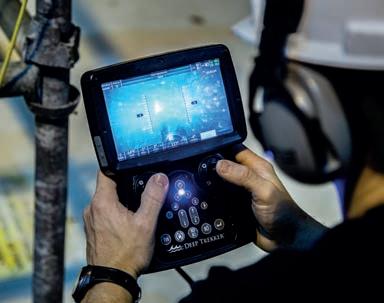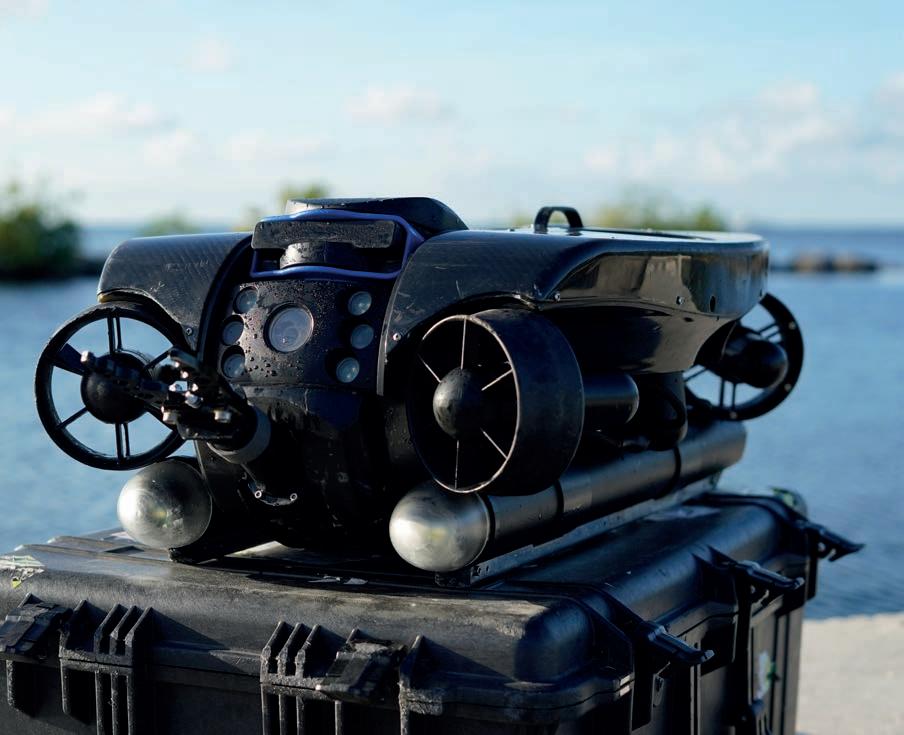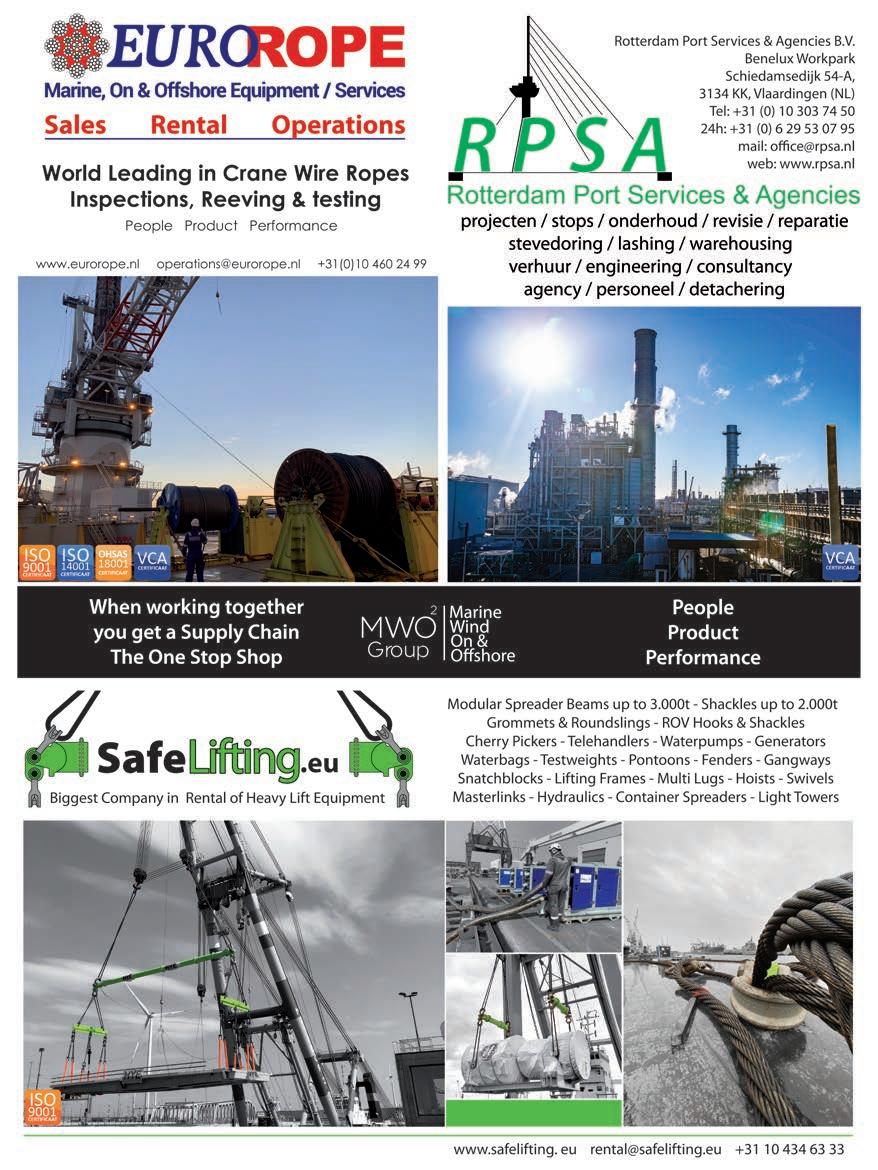
6 minute read
Optmising dive operatons with ROVs
Optimising Dive Operations with ROVs
REMOTELY OPERATED VEHICLES (ROVS) ARE A VERSATILE TOOL USED TO ASSIST COMMERCIAL DIVERS AND MARITIME CONTRACTORS IN PERFORMING INSPECTIONS IN BOTH ENCLOSED SPACES AND OFFSHORE, OPEN WATER APPLICATIONS.
ALL PHOTOS COURTESY OF DEEP TREKKER
While consistent infrastructure inspectons are necessary for operatonal safety, employing divers for routne inspectons is an unnecessary risk that is ofen dangerous and inconvenient.
The best team
The diving industry plays a signifcant role in ocean exploraton, infrastructure, aquaculture, military and salvage operatons. In additon to taking care of problems in the marine world, commercial divers also perform inspectons and fx issues in various industrial situatons. Nuclear power plants for example require consistent inspecton to ensure structural integrity on submerged components. Structures like cooling tanks require regular inspecton and cannot be drained for routne inspecton. Submersible ROVs and commercial divers are truly the best team for completng underwater tasks. Combining the strengths of both divers and underwater ROVs creates a mutually benefcial relatonship. The goal of an ROV is not to replace a commercial diver but to complement them.
Keyways
With such a broad and potentally dangerous breadth of tasks, underwater drones can assist divers to maximise efciency, efectveness, and safety in fve keyways.
Pre-Dive Check Diving is inherently dangerous, no mater the situaton. Human safety is paramount in any mission. Before sending a human under the water, an ROV can conduct a safety survey to ensure that the job is safe for a diver. Using the underwater drone dive teams can accurately and efciently check for any underwater risks. Protruding branches or wires that divers could get snagged on can be identfed in advance to prevent incidents. Varying water conditons or other nearby hazards can be spoted easily, allowing teams to enter the water prepared. Furthermore, the ROV pre-check provides users with a lay of the land. Divers can get their bearings before they even enter the water. Operators can also look for potentally hazardous or confned spaces to avoid or plan for.
Accurately quote contracts An ROV pre-check enables dive teams to fully examine the upcoming mission. Before a diver even dips a toe in the water, the ROV can be deployed to identfy the area that needs to be worked on. The scope of the task can be fully understood, including personnel required, equipment, tme, etc. By employing the ROV, teams are able to adequately prepare and schedule for the job. By gathering a complete understanding of the task at hand, dive teams are wellequipped to provide clients with reliable informaton and accurate quotes to ensure exceptonal service.
Add a new revenue stream Inspecton contracts around the world are becoming increasingly compettve to win >>
Using the underwater drone dive teams can accurately and effciently check for any underwater risks.



Inspecting submerged infrastructure with the Deep Trekker Evolution. Diver safety can be optimised with the use of an ROV.
The goal of an ROV is not to replace a commercial diver but to complement them.

and companies are preferring lower risk inspecton optons such as robotcs instead of manned inspectons. Having a ROV allows your dive business to compete for these contracts by reducing the cost of performing many inspecton tasks as well as enabling you to ofer a safer alternatve for performing the inspecton.
Dive Monitoring Diver safety can be optmised with the use of an ROV during the dive as well. By monitoring divers from the topside, operators can ensure safety and security for divers. Those topside can ensure that divers are safe and follow safety protocols. Realtme video observaton allows any issues to be caught at once with immediate emergency assistance if necessary. Whether open water or confned spaces, real tme monitoring is incredibly benefcial for scuba diving safety.
Post-dive evaluation Operatng an underwater robot from topside also allows for the dive to be accurately recorded for later review. Recording underwater dive operatons in 4K UHD provides value to both divers and their clients. Commercial diving companies can show the video to their clients to show their valuable and important work. Recorded video also gives concrete proof of the work completed, work that can otherwise be difcult to demonstrate. Divers can also evaluate dives to determine where operatons and efciency could be improved to maximise their job performance. Recorded videos can be used for training purposes at both dive centres and commercial diving companies to show specifc diving procedures for students. Companies can also use the video recorded from the ROV to create a historical directory of diving content for marketng, documentaton and review purposes.
Looking to the future of ROVS
Submersible ROV company Deep Trekker provides an easy, efcient and safe inspecton tool for ofshore structures including sea chests, ballast tanks, moorings, risers and legs. Deep Trekker’s batery powered and easily deployed ROVs are quick and easy to use – providing dive teams with a reliable way to confrm the safety of their mission. The future of the ROV industry trends towards autonomy. The transformatve impact of autonomous underwater vehicles (AUVs) on marine industries has the potental to be tremendous as the adopton of such technology becomes commonplace. As increasing adopton of AUVs leads to further investment in AUV technology, vehicles are certain to become more advanced and ofer even further benefts to users. The evoluton of AUV technology has and will contnue to rapidly evolve as new vehicles, technologies and applicatons grow.
Advanced navigation and stabilisation
Taking a big step towards developing a hybrid autonomous vehicle, Deep Trekker released a new ROV package, the Revoluton NAV. Building upon the Revoluton ROV, the NAV ofers advanced navigaton and stabilisaton, leading the way in semiautonomous vehicles. The REVOLUTION NAV package tackles underwater navigaton by providing pilots with a Google map showing their ROV’s positon on screen, allowing users to see where they are, leave a trail to show where they have been and set points of interest to where they want to return to. Furthermore, advanced stabilisaton features allow operators to staton hold against currents, enable auto alttude and pilot their vehicle precisely and accurately through varying water conditons.
Complex operations
The REVOLUTION NAV’s capabilites are especially useful for applicatons in open, murky water or when there is signifcant current. The state-of-the-art features provide benefts across numerous applicatons for missions requiring precise navigaton, locaton tracking and reportng. The pairing of USBL and DVL with Deep Trekker’s BRIDGE technology and sensor fusion bring this intelligent navigaton system to life. USBL systems utlise sonar beacons to triangulate the positon of the ROV. A GPS chip inside the Deep Trekker BRIDGE controller allows the system to correlate the data and provide real tme lattude and longitude. DVL ofers users an enhanced navigatonal system by providing pilots with the ability to accurately and conveniently determine velocity relatve to the seafoor, allowing for easy navigaton through the most complex of operatons.
i. deeptrekker.com











